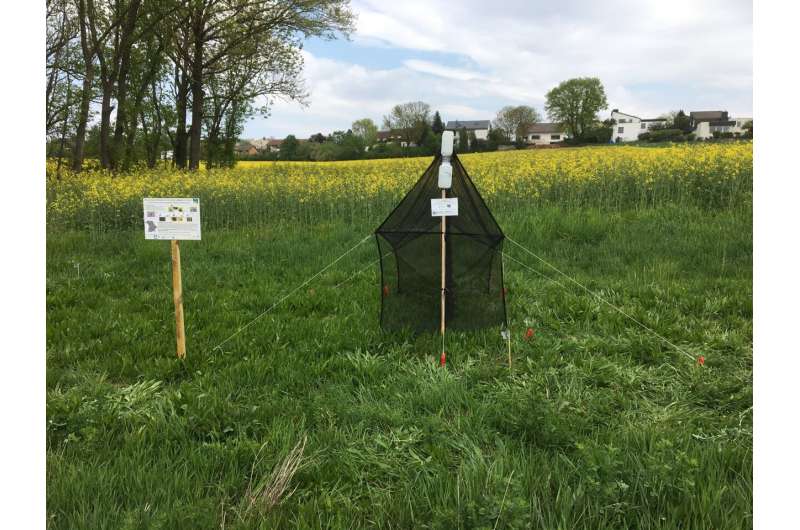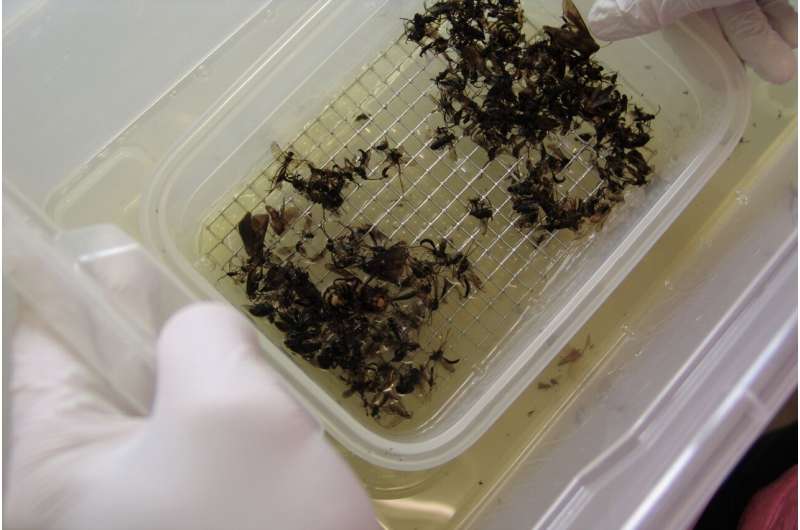Malaise traps are highly suitable for collecting a variety of insect species in different habitats. Credit: LandKlif team, Bavaria
Worldwide, scientists have reported mounting evidence that the quantity and diversity of insects are declining; in politics and society, these findings have raised great concern.
Researchers attribute the decline in insect numbers to changes in land use, for example, to the increase in large monocultures such as maize and rape, but also cite climate change with increased temperatures and drought as a cause.
However, these findings seem to have weaknesses, says animal ecologist Professor Jörg Müller from the Biocentre of Julius-Maximilians-Universität Würzburg (JMU) in Bavaria, Germany. Among other things, the underlying studies so far do not represent the diversity of insect species well enough or only consider short periods of time and small areas.
A research team of the Bavarian LandKlif network, coordinated by JMU, wanted to remedy this shortcoming. The results of their study have been published in the journal Nature Communications. They show that urbanization is another key factor for the overall decline of insects.
Study at 179 sites from low to high elevations
From Lower Franconia to Upper Bavaria, the researchers placed traps to collect flying, crawling and jumping insects in spring 2019. These Malaise-traps were located at 179 sites, from the lowlands to elevations above 1100 meters in the Bavarian Forest and the Alps. They were located in forests, on meadows and fields as well as in settlements, embedded in semi-natural, agricultural and urban landscapes.
The researchers emptied the traps every 14 days for an entire vegetation period. They determined the biomass of the insects caught and identified the individual species using DNA sequencing.
Sample of insects caught in Malaise traps. Credit: Landklif team, Bavaria
Insects benefit from higher temperatures
"In this study, we were able for the first time to disentangle the impact of climate and land use on insects in a Central European landscape," explains Jörg Müller. "Interestingly, temperature at the local site as well as annual temperature have only positive effects on the biomass and diversity of insect populations. The form of land use, on the other hand, has different effects on biomass and diversity."
"We observed the largest difference in insect biomass between semi-natural and urban environments. In the city, the biomass was 42 percent lower. Insect diversity was 29 percent lower in agricultural environments compared to semi-natural habitats. There were even 56 percent fewer endangered species in agricultural areas," says Johannes Uhler, JMU Ph.D. student and first author of the study.
Consequences for insect conservation
"These contrasting patterns of biomass and species diversity are an important warning sign for researchers," says Uhler: For insect monitoring, one should not conclude that a decline in biomass also means a decline in species diversity, and vice versa.
Based on its new findings, the JMU researchers recommend creating more green spaces in urban environments to increase insect biomass. Existing agri-environmental schemes should be further expanded to improve biodiversity and forest habitats should be promoted.
More information: Relationship of insect biomass and richness with land use along a climate gradient, Nature Communications (2021). DOI: 10.103841467-021-26181-33
Journal information: Nature Communications
Provided by University of Würzburg

























